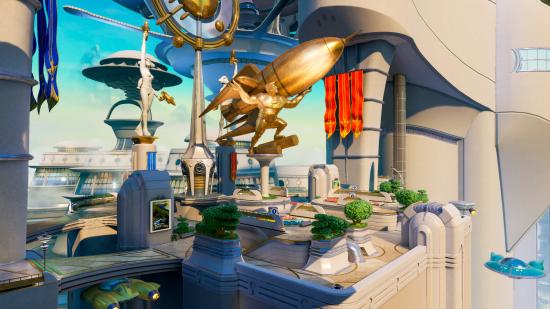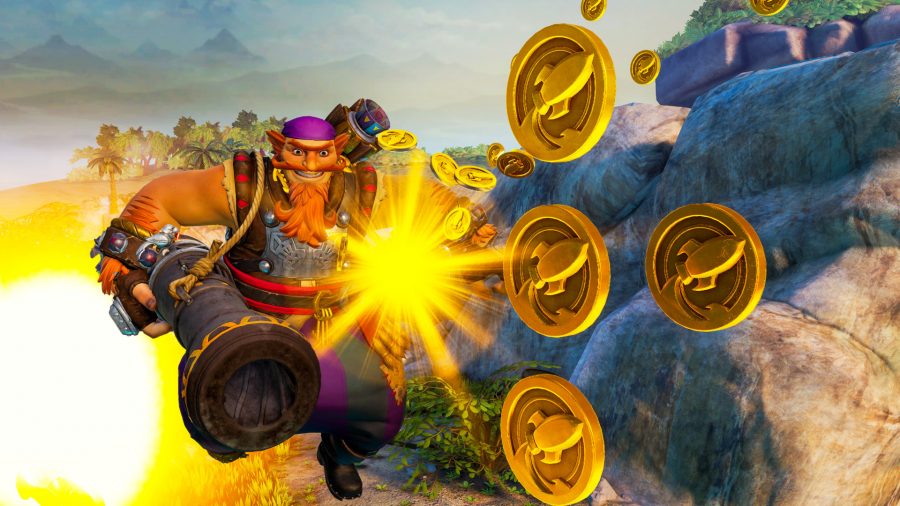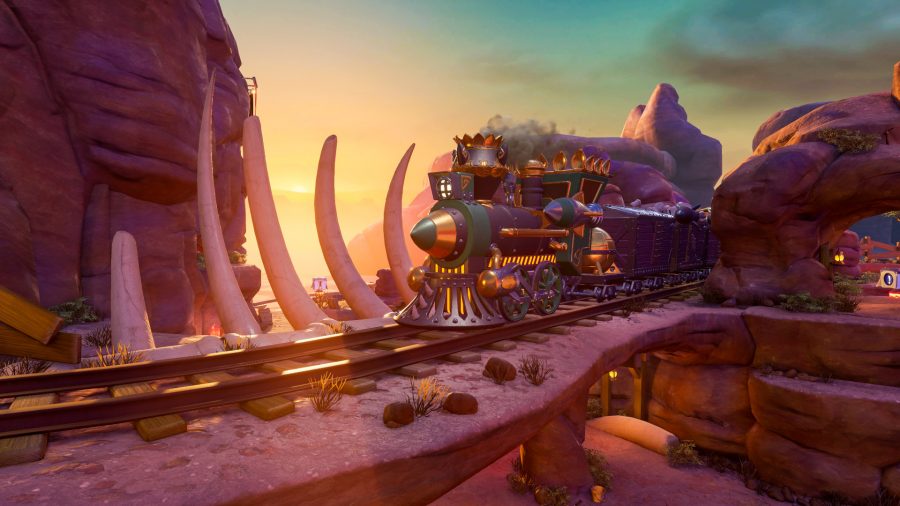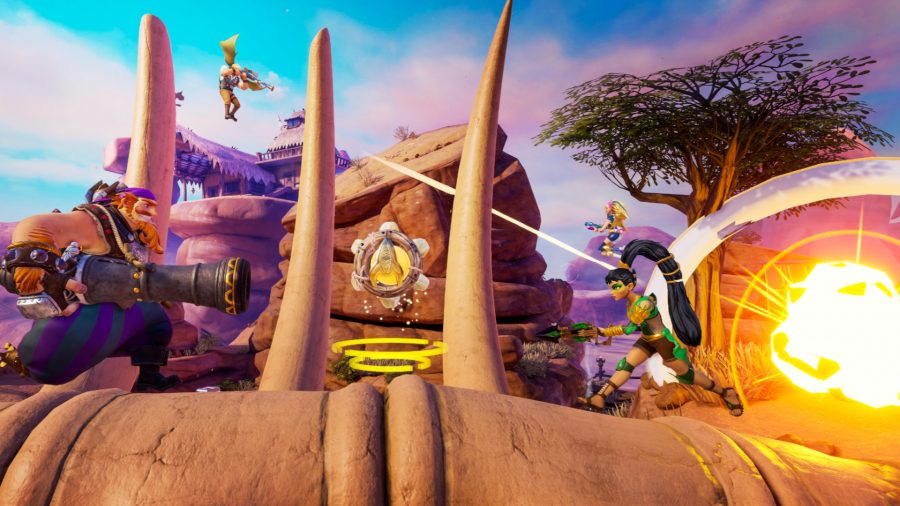Rocket Arena is the next project out of the EA Originals programme – one that blends the fast action rocket mechanics of games like Quake, the hero powers of Overwatch, and the knockout mechanics of Super Smash Bros. Developer Final Strike Games has been working Rocket Arena since long before the EA partnership, however, and years of development has seen the game make some major transitions – including the switch from first-person to third, and a change from free-to-play to a premium release.
The fast-paced action made a strong impression on me during a recent preview event, and you can read more on Rocket Arena’s gameplay at that link. But the questions remain: How will Rocket Arena fit into the broader market of multiplayer games, and how will Final Strike keep the community fed post-launch?
We got to chat with lead designer Gregg Metzler and lead animator Lahela Schoessler about those topics and more, including how they decided to make a shooter where no one dies. (And yes, before the Battlefront II launch nightmares dig in too deep, EA and Final Strike have confirmed that all gameplay-influencing items are unlocked through playing, and everything else will be cosmetic.)
PCGamesN: It’s been awhile since Rocket Arena made its initial debut in various beta forms, and the game has changed quite a bit since that time. How has player feedback shaped the game heading into release?
Gregg Metzler: It’s been just an awesome journey. When the game was out in beta, we got tons of cool feedback. Anything from character balance to, ‘hey, we need to flip the X-axis on mouse.’ We’re like ‘Oh, really, I didn’t know people did that.’ When we put it out there, we started getting great feedback, and then that drove us to create those features. For example, with the X-axis on the mouse, we were able to get that in for them and make their day within a couple days of beta. That was pretty exciting.
As we played, we reflected on it, and wanted to lean into our our key systems that makes Rocket Arena super unique and super fun – rockets-only gameplay and never-say-die combat, where every time you blast somebody, you fill up their blast meter, and the more they’re blasted the further they fly. Just through playing that beta, there was a whole lot of, ‘well, do I always get knocked out with a mega blast, or is there a way to get out of that?’ ‘Whenever I’m getting hit too many times it feels like I’m stuck.’
We just looked at that and did play tests and went ‘is there really something here?’ Then that drove ‘Okay, what if we could do a dodge mechanic?’ Then a player can hit a button and counter that stun or being hit repeatedly. It drove us to playtest that new system, get that dodge mechanic, and that’s one of the reasons why we switched to third-person – that clarity of combat and leaning into those key fun elements of Rocket Arena.
The switch from first-person to third seems like an especially challenging shift. How did that change come about, and what have been some of the consequences of it?
GM: Originally, we were doing a whole lot of ‘well, let’s try out third-person.’ So we did internal play tests with it in third-person, and once we started leaning into that, with more and more of impulse based mechanics and once we got that dodge system in there, then all of a sudden, it just felt way more natural to be in third-person.
What we were experiencing with Rocket Arena was that a lot of first person shooters are kind of planar, so you’re battling on this X-axis, and rarely do you have to look up or down on the Y-axis. In our game, you can rocket jump, you can rocket climb, you can save yourself at the bottom of a level or just climb all the way up to the top of a level. We found our players were constantly looking 360 degrees and couldn’t quite tell sometimes where rockets were coming from or even how to dodge them. A lot of that was through playtesting and it felt more natural making that switch to third-person.
Lahela Schoessler: Aesthetically, as an animator it was so much fun to be able to express our characters more, with full body animations, and let the player see all of their character. We have unique personality-driven animations for reloads, and all of their abilities. It was really exciting for us to be able to show our wide variety of characters more with all their different personalities.
GM: And then you say consequences. Lahela’s team did first-person animations, so when you switch to third-person, then her team had to really polish up third-person animations and make those shine. That was definitely one of the consequences. Her team just did a super great job. She’s talking about those fun reloads where Jayto throws his ammo behind his back and catches it with the gun. All of that was added originally because we’ve got to polish up these third-person animations, but then on the positive side now we get all these fun animations because of it.
A challenge for a lot of hero-based shooters is keeping the action easily readable with so many heroes using unique abilities on the battlefield. What’s been your approach to making sure the action remains coherent?
LS: We playtest a lot. Everyone plays the game.
GM: We have daily playtests and we still yell at each other while we’re doing them.
LS: In a very, you know, fun way. [laughter]
GM: Not an anger-driven way. [laughter]
A lot of it comes down to character design. That goes all the way to how the rockets are unique to every single character. Which helps gameplay and helps design. We work very closely as designers with Lahela’s team. with the character modeling team.
The goal is that when Topnotch fires one of his grenade rockets, you can hear that it’s a Topnotch grenade. You can see that it’s a very unique projectile flying through space. You’re like, ‘Oh, geez, I can tell’, as they’re whipping by, ‘that’s a Topnotch firing at me from above’, or those huge cannonball rockets from Blastbeard. So not only are they themed, we get to have a nice ‘design backs up art, art backs up design’, and then it actually improves our gameplay readability and clarity, because you can tell – just based on whose projectiles are flying at you – the state of the game.
LS: Once we get the models into the game, we say ‘okay, go run really far away and then shoot directly at me so I can see what the projectile looks like when it’s coming at me. Shoot to the side, so I know it’s a very easy read this way and that way’, and we do that with all of our characters. From the trails of the projectile itself to the muzzle flash and impact, it’s all very thought out.
GM: Each one has a color palette theme. They have an audio theme, and a VFX theme. All of it helps that gameplay clarity that you were talking about.
LS: They’re all about rockets.
That ‘all about rockets’ theme seems to go beyond the gameplay into the aesthetics and lore of the world, too.
GM: From a design standpoint, it was like, ‘does it have a rocket? No? Well, we should put a rocket in it.’ Even the leaves are shaped like rockets. Their icons, their logos, filigree on their outfits and their belt buckles. We’re like let’s make this whole thing a world that is themed around rockets. So the mechanics are backed up by the art.
LS: Our environment team had a lot of fun with it. I think that there are still some surprises, where I discover while I’m walking around like, ‘oh, okay, look at that mountain. I didn’t even- okay!’ We have our crabs that are doing little dances and they have their rocket bellies in Amphora’s world. For the character team, we do exactly what Greg was saying. ‘What should we do here? It’s missing something. You know what, let’s just add a rocket to that, that will be great.’ My favorite is Topnotch’s rockets with mustaches. It’s not just rockets, it’s rockets with personality that are themed to our characters, which makes it a lot more fun to play with and appealing.
GM: And it comes all throughout it, not just the visual style. We worked with Len Uhley, who is one of the writers from TaleSpin. We had a really fun back and forth to develop the world of Crater, and how all these rockets are part of that world. We’re gonna continue to reveal to the public what that story is, what that lore is, and just keep building it. It’s even a culture for these people. They come from different regions that have their own way that they interact with rockets. It’s gonna be really fun to keep building on that and showing our player base what’s to come. (More rockets.)
LS: Our art director, Dev Madan, who was the creator of Sly Cooper, has that very creative colorful style and the humor that he injects into the aesthetics of the world.
It’s tough to talk about Rocket Arena without evoking Super Smash Bros. with the ring out mechanic. It’s a distinctive mechanic that doesn’t show up in a lot of games – how did it evolve in Rocket Arena?
GM: Yeah, it’s kind of odd that you don’t see it more. Our team at Final Strike is completely passionate about multiplayer games. The whole studio’s played tons of rockets-only mods and multiplayer in general. Like Smash Bros., which is a super fun game. But from how Rocket Arena was started, it’s actually a very organic process. I remember hearing a comment that was ‘I really like playing your game, but I just can’t help my team. I’m not good enough. I just keep dying.’ The design that came out of that was ‘okay, well, what if we made a game where no one dies? How do you solve for that in a design sense? Well, if they don’t die, they need to still move away from the space somehow, so maybe we can push them away from it.’
That’s how it organically started being ‘okay, maybe they’re these objects that fly through space. What could push things? Hey, remember when we played rockets-only mods or rockets games? Why don’t we just make it all about rockets.’ Then this never-say-die gameplay mixed with the it’s-all-about-rockets game mechanic, and then it’s just one step after another. Even in very early gray box tests, where everybody’s shooting squares around, it was all about that impulse-based mechanic with players able to come right back into the gameplay. It started just as answering that design question of ‘how could we make a game where no one dies? How would that be possible?’ That’s what kicked it all off.
The era of cross-play that we’re entering is exciting, but it presents a balance challenge for shooters in particular. What’s been your approach to balancing controllers against keyboard and mouse?
GM: Our QA team is super cool – when they play hard, you get smoked by them. They’re so good at Rocket Arena that they’re doing things like flying through the air, doing corkscrews, all these different moves, like I don’t know how they’re doing that. A lot of them are actually ex-pro Halo players, so they were controller-first. We worked very closely with them to tune and balance and polish controller and how it felt. We’re very proud of how controllers feel.
We have aim assist to help players get to target, but in Rocket Arena it’s not hitstun weapons. You’ve got to learn to master your rockets. You’ve got to learn your character’s unique abilities. So you’ve got to learn to lead, anticipate, and guess what your opponents are going to do. There’s a lot of deep skill being able to have that nice, intense battle with an opponent.
We did tons and tons of controller testing with keyboard and mouse alongside. We’ll edit and change stuff as we need to, to continue to polish that. We have settings for stick acceleration, you can turn that on and off. There’s also miscellaneous analog settings for stick tuning – for players to be able to customize and edit it to what feels good for them. And we’ll continue to keep refining, of course.
And if players don’t want to participate, that’s also a setting. They can turn cross-play off and just play with their platform. We’ve been testing and we find controllers to be enjoyable and competitive with keyboard and mouse players.
Is there cross-progression?
GM: There is not cross-progression. We have cross-play friends, cross-play parties, and cross-play gameplay. But we don’t currently support cross-play progression.
How does the PvE mode work?
GM: The PvE mode is you and up to two other friends – so it’s three of you on a team – or just matchmake solo, and you’ll get matched up with other players. You’re battling hordes of rocket bots, which are AI opponents that run around whichever map you’re loaded into. You want to knock out 25 bots in the time limit and don’t get knocked out yourself. Each player has three badges on them. If you’re knocked out, you’ll lose a badge. But if you lose all of your badges, you’re not out of the game – you get to play and support your team. So if you’ve got one teammate with one badge and you’re still fighting against those bots, and the time limit hasn’t run out, you’ll want to protect your one teammate and then try to manage that offensive and defensive aspect of it.
One of the other big changes from those early plans was the switch from free-to-play to a paid release. How has that affected your approach heading into launch, and on post-launch content?
GM: We felt like it was the best solution for the players because it enabled us to just make tons of cool content. We’ve got 10 characters, and five modes, counting our PvE mode. It allowed us to do cross-play. We’ve got a post-launch plan that comes two weeks after release. So July 28, we have over 100 levels of Blast Pass, which is our seasonal pass system. Then every single season, we’re gonna have new characters, new maps, new modes, themed events, tons of challenges, and all that stuff is free and comes with the game. So it was a really neat way for us to be able to support the community and put players first. We’re really excited about that aspect.
What’s been your approach to designing cosmetics and those hooks to keep players coming back?
LS: I love how fun and silly our costumes are. It’s been exciting to play around with themes for the events we have in store. We talk through the personality of the characters a lot. Like what would Blastbeard be wearing if he were stranded on an island? That kind of stuff for playing up their lore.
GM: Yeah, tying it into the backstory and bringing the world of Crater forward through these different events. Each one of these themed events is always pushing the backstory and some part of the history. Even outside of the whole Blast Pass – which has a free tier, with a whole bunch of stuff – each character has 100 levels of free progression. So every time we release a new character, they have 100 levels of unlocks just by playing. Then things are dropped in our event store. And you can just play for free to unlock rocket parts to be able to get that stuff as well. So we allow players to play to unlock, customizing, and add stuff as they want.
LS: When we design skins it’s not just the character that we’re designing. We’re continuing to design the projectile. When Topnotch is shooting his projectile at you and he’s equipped with a skin, we make sure that it looks different because it is a different skin, but we also make sure that you know that it’s Topnotch shooting his projectile at you. So every time we do a new skin, we are taking a look at that rocket, because… rockets.



